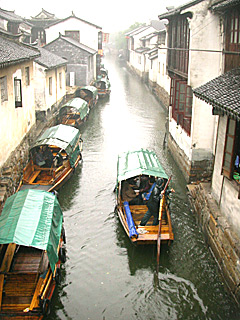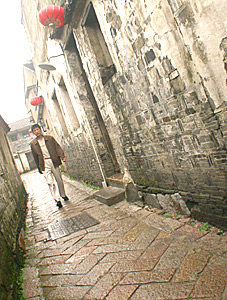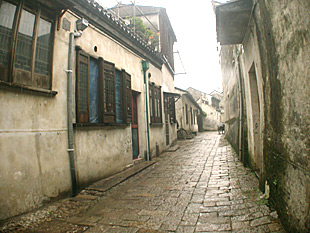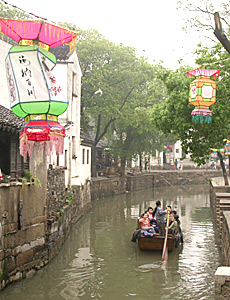Cashing in on Old China
As cities across China race pell-mell to modernize, tearing down tiled-roof houses and replacing historic lanes with highrises, half a dozen towns on the Yangtze River are going against the current, restoring cobbled lanes and banking on the past.
By Ron Gluckman - in Shanghai, Zhouzhuang, Tongli and other parts of the Yangtze
AS CITIES ACROSS CHINA modernize at a frantic pace, half a dozen picturesque towns perched along the waterways west of Shanghai have taken an opposite tact, pinning their hopes for the future not upon high-rises and miles of blacktop, but in the bygone simplicity and rustic structures of the ancient past.
 These Yangtze River towns invested millions of dollars to restore old
temples, wooden shops and courtyard houses, many dating to the early Ming
Dynasty, an eon ago. And they look the part, ancient outposts distinguished by
curved tile roofs and charming cobbled alleys leading to exquisitely-arched
bridges that crisscross the canals.
These Yangtze River towns invested millions of dollars to restore old
temples, wooden shops and courtyard houses, many dating to the early Ming
Dynasty, an eon ago. And they look the part, ancient outposts distinguished by
curved tile roofs and charming cobbled alleys leading to exquisitely-arched
bridges that crisscross the canals.
Hence, Zhouzhuang, Tongli and Luzhi in Jiangsu Province, and Nanxun, Xitang and Wuzhen in Jiangsu Province, might be considered models for preservation. Collectively, they are applying for UNESCO World Heritage Status.
Each within an easy day trip from Shanghai, Hangzhou or Suzhou, these picturesque towns feel centuries distant. Sipping tea set upon stone tables, one can watch wooden gondolas drift down willow-draped streams, lit by flickering lantern, and feel just like the first tourist, soaking up a scene that probably hasnít changed much since the time of Marco Polo.
All of the towns had a heyday of sorts centuries ago, as trading posts on tributaries of the Grand Canal, once the Middle Kingdomís main route of transport. Sagely, they are reaping dividends from the richness of traditional village life; tourists now flock here to rediscover the flavor of old China.
Success has not only spawned legions of imitators Ė newly-restored river towns are springing up throughout the delta Ė but ample critics.
"You really should have visited a decade ago, or 15 years back, before anyone knew about these places," says a friend who writes guidebooks about China. "Now, itís too late. Theyíre all overrun, ruined."
 Bearing this in mind, I initially decide to skip Zhouzhuang, which prides
itself as "The Number One Water Town in China." Oldest, biggest and
most developed of the water towns, Zhouzhuang draws an astounding 2.5 million
tourists each year.
Bearing this in mind, I initially decide to skip Zhouzhuang, which prides
itself as "The Number One Water Town in China." Oldest, biggest and
most developed of the water towns, Zhouzhuang draws an astounding 2.5 million
tourists each year.
Yet it was like a ghost town until the early 1980s, when painter Chen Yifei brushed its Twin Bridge on canvas, for a show in New York. Armand Hammer bought the painting and presented it a month later to Deng Xiaoping. Suddenly, Zhouzhuang was a secret no more.
Nowadays, friends rave about Tongli, second-largest of the river towns, but not as easy to reach. After a bit of bargaining, I settle on a price about $80 for a taxi for the day, and set off for to make my rounds of the river towns, starting with Tongli.
Sprawling across a series of lakes, islands and canals, Tongli makes a visible case to its claim as "Venice of the East." Practically all the homes and shops front water: there are five main lakes, all connected by canals, crossed by some four dozen bridges.
Tongli also boasts spectacular gardens, most prominently Tuisi (Retreat and Meditation), laid out by official Ren Lansheng after his retirement in the late 1800s.
Touring the enormous interior garden, paths winding around fish ponds and dotted with ornate wooden pavilions, provides a taste of long ago life - for the privileged. The sprawling residence is equally impressive, with tea room, sedan hall and endless chambers.
Renís miniature palace is only one of many historic structures in town. But I soon tire of the itinerary suggested by guidebooks and followed by most group tours. Instead, I joyfully lose myself in irregular alleyways, which shoot like ant trails, in all directions from the various waterways.
Tongli is a marvel of China, one of those magical places where no map or agenda is necessary. Around every corner is a shop selling something novel, or a bench shaded by greenery, perfectly placed to soak up the local flavor.
 Tongli feels utterly authentic, thanks to a preservation effort rare in
China. The entire core of this thousand-year-old town seems frozen in time.
There is a congruity that makes it seem a tiny, perfect world to itself.
Tongli feels utterly authentic, thanks to a preservation effort rare in
China. The entire core of this thousand-year-old town seems frozen in time.
There is a congruity that makes it seem a tiny, perfect world to itself.
Unlike Medieval villages in Europe, there are no towering spires or castles. Likewise, no cars, only the thin, delightfully irregular, cobbled alleys. And white stone buildings and ragged tile roofs sagging with age so convincing, the town has served as a set for over 100 local TV and movie productions.
Sadly, there are establishments that tatter that illusion, particularly around the edges of this remarkable relic. The growing ranks of tourist and trinket shops are bad enough, but oddest of all is The Chinese Ancient Sex Culture Museum.
Originally opened in Shanghai, the controversial museum moved several times, before closing altogether. Then, the Tongli government moved the 5,000 item collection here last spring.
Actually, there is nothing tawdry about the exhibit, nicely displayed in a century-old former girlís school, its gray stone covered in ivy. And Chinese tourists love the place. Still, itís a worrying signal about the future for these water towns, which development could produce glitzy roadside attractions on the back roads between Shanghai and Suzhou.
Fortunately, little such development yet mars Luzhi, Nanxun, Xitang or Wuzhen.
 Just 18 kilometers from Suzhou, Luzhi is smallest of the historic river towns;
the old town is only one square kilometer. Yet it claims a greater density of
waterways and bridges than Venice.
Just 18 kilometers from Suzhou, Luzhi is smallest of the historic river towns;
the old town is only one square kilometer. Yet it claims a greater density of
waterways and bridges than Venice.
More than 40 bridges in all shapes and sizes crisscross the web of canals. Group tours rarely stop here, or in Xitang, oldest of the river towns. Dating back 2,500 years, Xitang claims over 100 bridges and a unique style of local architecture dictated by the heavy rainfall.
Overhangs were tacked over doors, connecting over the ages to form a colorful patchwork of covered corridors; the longest stretches some 1,300 meters.
All the towns have basic guesthouses, but most visitors come on day trips, as there is little to entertain tourists for lengthy stays.
The real appeal has a lot to do with the shift in tourism in China. A dozen years ago, Suzhou was an adventurous getaway from Shanghai, where those with the time could plunge into the heart of China, relishing a glimpse of the past.
Now, itís only a couple hours from Shanghai on fast highway, and a well-known destination itself. So, tourism pushes to new frontiers, like the river towns.
Purists shun Zhouzhuang, just 60 miles from Shanghai and in the target sights of all the group tours. They swarm local mansions like Shenís House, with over 100 rooms, and scamper over the rock gardens, flinging flecks of food to goldfish in the massive courtyard ponds.
 Without a doubt, there is much to
revile about Zhouzhuang, from the overly-lavish restoration to a profusion of
trinket stalls stocked with communist kitsch, painted silk scrolls and
calligraphy.
Without a doubt, there is much to
revile about Zhouzhuang, from the overly-lavish restoration to a profusion of
trinket stalls stocked with communist kitsch, painted silk scrolls and
calligraphy.
Yet, Zhouzhuang shares the seem scenic charms of all the river towns, the maze of mystifying alleys and alluring old-world architecture. And even amongst the throngs, you can find serendipity by rounding a corned to discover a gaggle of women playing mahjong, fishermen studiously repairing nets, or a tiny teahouse perched on a willow-lined canal, where deeply-steeped doses of history can be savored for pennies a cup.
Truth be told, there is just more of everything to marvel at in Zhouzhuang, ancient attractions mingling with modern amusements at every turn. Despite the admonishment of my friend, I was bowled over by the place.
And Iím not alone. Chinese tourists pay as little as 128 yuan ($15) for bus tours from Shanghai, which includes the 60 yuan admission charged for admission to the old city and the major museums, houses and sights.
A thousand years of history for 15 bucks, including lunch. Thatís what Iíd call a delicious bargain.
Organized bus trips to either Tongli or Zhouzhuang cost as little as 128 yuan ($15) from Shanghai, which includes the 60 yuan admission package for all the city sights. Unfortunately, the tours are only with Chinese guides and suffer from the worst of package trips.
Hotels offer group tours or private cars to various river towns. Wild China (www.wildchina.com) offers tours to little-visited Xitang and Wuzhen, in a package from Suzhou to Hangzhou and back to Shanghai.
Ron Gluckman is an American reporter who has been covering China for 14 years from bases in Hong Kong and Beijing (althspent 14 years in Greater China (living and working in Hong Kong and Beijing), who roams around Asia for a number of publications, such as Destinasian, which ran this story in December 2004.
All pictures by Ron Gluckman
To return to the opening page and index
push here
[right.htm]
